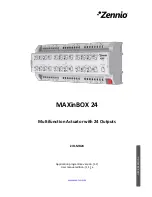
Hardware Description
6
SPRUII7 – June 2018
Copyright © 2018, Texas Instruments Incorporated
C2000™ Piccolo™ F28004x Series LaunchPad™ Development Kit
2.1.2
LEDs
Two power indicator LEDs are included on the board: LED0 indicates when the 3.3 V is available on the
USB side of the isolation barrier and LED1 indicates when 3.3 V is available on the device side of the
isolation. LED1 indicates that there is power supplied to the F28004x device as well as the XDS110
debugger.
Two user LEDs are provided on the board: LED4 (red) and LED5 (green). These user LEDs are
connected to GPIO23 and GPIO34, respectively. These are connected to the SN74LVC2G07DBVR LED
driver IC and are connected in an active low configuration; that is, drive the GPIO low to turn on the LED
and high to turn it off. These LEDs are dedicated for use by the software application.
Two blue LEDs, LED2 and LED3, are connected to the XDS110 debug probe. These indicate debugger
activity and are not controllable by any application software.
2.1.3
Encoder Connectors
The F28004x LaunchPad includes two headers, J12 and J13, which are used for connecting linear or
rotary incremental encoders. These headers take 5 V signals that are down-converted to 3.3 V and wired
to the F280049C MCU. These signals are connected to the eQEP modules on the device. Each header
has the EQEPA, EQEPB, and EQEPI signals available for each eQEP module as well as pins for GND
and 5 V.
2.1.4
FSI
The F28004x MCU features the industry first Fast Serial Interface (FSI). The FSI enables robust high-
speed communications and is intended to increase the amount of information transmitted while reducing
the costs to communicate over an isolation barrier. Though no isolator is included on this LaunchPad, the
TXCLK, TXD0, RXCLK, and RXD0 signals are available on J11. This header is set up in such a way that
adding two jumpers will connect the TX to RX channels for loopback and evaluation. Additionally, each
signal has an adjacent GND signal, allowing for a wrapped-pair connection to an external board with FSI.
The GPIOs connected to this header are also routed to the BoosterPack connectors through 0
Ω
resistors.
As the FSI can toggle at up to 100 MHz rates, the longer traces to the BoosterPack headers can create
unintentional noise on the signal due to reflection. Eliminating these extended traces by removing the in-
circuit resistors will help to limit any noise or reflections.
2.1.5
CAN
The F28004x LaunchPad includes a connector for a CAN network through J14. GPIO32 and GPIO33 are
routed from the F280049CPZS to J14 through the on-board CAN Transceiver. GPIO33 is also wired to the
FSI connector.
2.1.6
Boot Modes
The F280049C boot ROM contains bootloading software that executes every time the devices is powered
on or reset. Two pins, GPIO24 and GPIO32, are wired to the Boot Select switch (S2). Note that S2 is
placed upside down, so the OFF (open) position corresponds to a logic 1 and the ON (closed) position
corresponds to 0. By default, both pins are set to the OFF position so the device will boot from Flash. For
more information on the F28004x boot modes, see the
TMS320F28004x Piccolo Microcontrollers Data
.
Table 2. Boot Select Switch Settings
BOOT MODE
GPIO32 (Position 1)
GPIO24 (Position 2)
Boot from Parallel GPIO
ON
ON
Boot from SCI / Wait boot
OFF
ON
Boot from CAN
ON
OFF
Boot from Flash (default)
OFF
OFF







































